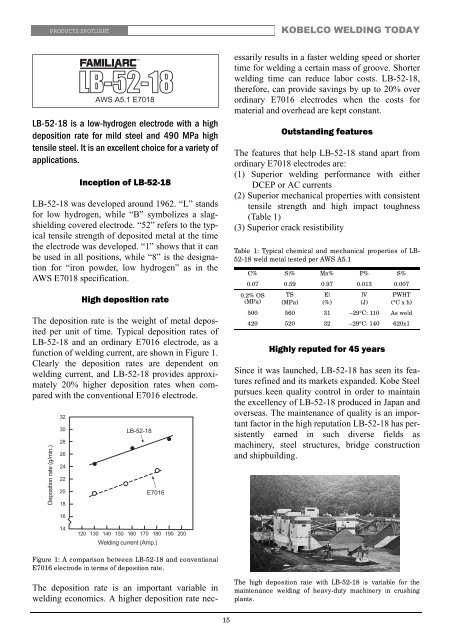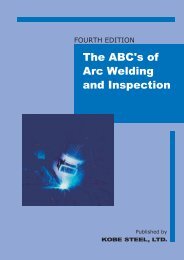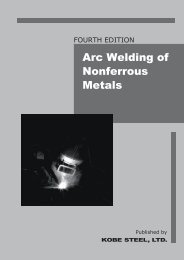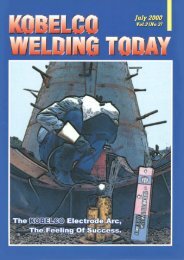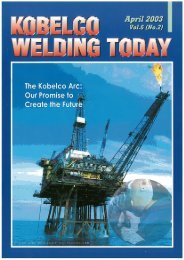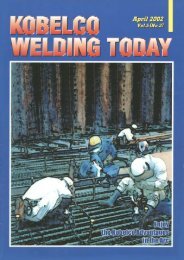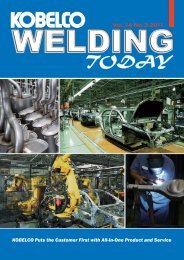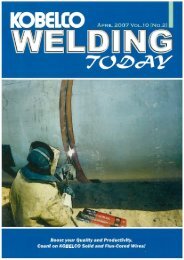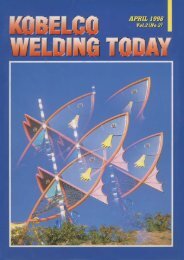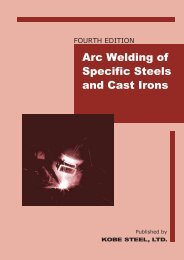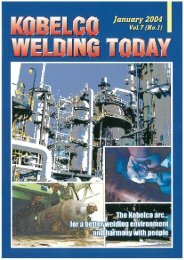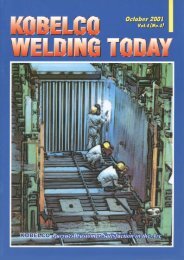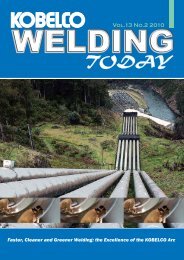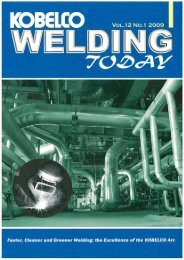KOBELCO WELDING CONSUMABLES
KOBELCO WELDING CONSUMABLES
KOBELCO WELDING CONSUMABLES
You also want an ePaper? Increase the reach of your titles
YUMPU automatically turns print PDFs into web optimized ePapers that Google loves.
PRODUCTS SPOTLIGHT<br />
<strong>KOBELCO</strong> <strong>WELDING</strong> TODAY<br />
LB-52-18 is a low-hydrogen electrode with a high<br />
deposition rate for mild steel and 490 MPa high<br />
tensile steel. It is an excellent choice for a variety of<br />
applications.<br />
Inception of LB-52-18<br />
LB-52-18 was developed around 1962. “L” stands<br />
for low hydrogen, while “B” symbolizes a slagshielding<br />
covered electrode. “52” refers to the typical<br />
tensile strength of deposited metal at the time<br />
the electrode was developed. “1” shows that it can<br />
be used in all positions, while “8” is the designation<br />
for “iron powder, low hydrogen” as in the<br />
AWS E7018 specification.<br />
High deposition rate<br />
The deposition rate is the weight of metal deposited<br />
per unit of time. Typical deposition rates of<br />
LB-52-18 and an ordinary E7016 electrode, as a<br />
function of welding current, are shown in Figure 1.<br />
Clearly the deposition rates are dependent on<br />
welding current, and LB-52-18 provides approximately<br />
20% higher deposition rates when compared<br />
with the conventional E7016 electrode.<br />
<br />
<br />
<br />
<br />
<br />
<br />
<br />
<br />
<br />
<br />
<br />
<br />
<br />
The deposition rate is an important variable in<br />
welding economics. A higher deposition rate necessarily<br />
results in a faster welding speed or shorter<br />
time for welding a certain mass of groove. Shorter<br />
welding time can reduce labor costs. LB-52-18,<br />
therefore, can provide savings by up to 20% over<br />
ordinary E7016 electrodes when the costs for<br />
material and overhead are kept constant.<br />
Outstanding features<br />
The features that help LB-52-18 stand apart from<br />
ordinary E7018 electrodes are:<br />
(1) Superior welding performance with either<br />
DCEP or AC currents<br />
(2) Superior mechanical properties with consistent<br />
tensile strength and high impact toughness<br />
(Table 1)<br />
(3) Superior crack resistibility<br />
Table 1: Typical chemical and mechanical properties of LB-<br />
52-18 weld metal tested per AWS A5.1<br />
C% Si% Mn% P% S%<br />
0.07 0.59 0.97 0.013 0.007<br />
0.2% OS<br />
(MPa)<br />
TS<br />
(MPa)<br />
El<br />
(%)<br />
IV<br />
(J)<br />
Highly reputed for 45 years<br />
PWHT<br />
(°C x h)<br />
500 560 31 –29°C: 110 As weld<br />
420 520 32 –29°C: 140 620x1<br />
Since it was launched, LB-52-18 has seen its features<br />
refined and its markets expanded. Kobe Steel<br />
pursues keen quality control in order to maintain<br />
the excellency of LB-52-18 produced in Japan and<br />
overseas. The maintenance of quality is an important<br />
factor in the high reputation LB-52-18 has persistently<br />
earned in such diverse fields as<br />
machinery, steel structures, bridge construction<br />
and shipbuilding.<br />
<br />
<br />
<br />
<br />
Figure 1: A comparison between LB-52-18 and conventional<br />
E7016 electrode in terms of deposition rate.<br />
The high deposition rate with LB-52-18 is variable for the<br />
maintenance welding of heavy-duty machinery in crushing<br />
plants.<br />
15


